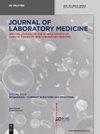Fully automated chemiluminescence microarray immunoassay for detection of antinuclear antibodies in systemic autoimmune rheumatic diseases
IF 1.8
4区 医学
Q4 MEDICAL LABORATORY TECHNOLOGY
引用次数: 0
Abstract
Objectives Detection of specific antinuclear antibodies is very important in term of diagnosis, prognosis and management of patients with systemic autoimmune rheumatic diseases. Chemiluminescence microarray immunoassay (CLMIA) is a microdot array-based method that allows simultaneous detection of multiple antinuclear antibodies, which received increasing attention. Methods A CLMIA method that can detect 14 kinds of antinuclear antibodies was established and optimized. Basic performance and diagnostic performance of CLMIA was evaluated by comparing it with line immunoassay (LIA) and indirect immunofluorescence (IIF). Results Through conditional exploration, the optimal blocking time and blocking temperature were determined to be 18 h and 25 °C, respectively. The enzyme-labeled secondary antibody reaction concentration was 0.1 μg/mL, the incubation temperature of serum and enzyme-labeled secondary antibody were 30 °C, and the incubation time of serum and enzyme-labeled secondary antibody were 40 min. After parameter optimization, CLMIA demonstrated high accuracy with a relative bias <15 %; high sensitivity with detection limits below 3 IU/mL for dsDNA and below 1 RU/mL for other ANAs; and high reproducibility with both intra-assay and inter-assay coefficients of variation (CV) <15 %.The CLMIA detection method established in this study was also demonstrated to have good clinical diagnostic performance, showing the highest area under curve (AUC=0.87, p=0.042 and p=0.03). The CLMIA and LIA revealed substantial to good agreements on specific antinuclear antibodies except anti-dsDNA, with the Cohen’s kappa from 0.72 to 0.89. Samples that produced discrepant results between the CLMIA and LIA methods were further analyzed. Upon additional testing, most of these samples were ultimately determined to have been correctly detected by the CLMIA assay rather than the LIA assay, suggesting that CLMIA also shows some superiority in diagnosing dsDNA. Conclusions The CLMIA could become a potential routine method for detecting ANAs with the advantages of good detection performance.用于检测系统性自身免疫性风湿病中的抗核抗体的全自动化学发光微阵列免疫分析仪
目的 检测特异性抗核抗体对于系统性自身免疫性风湿病患者的诊断、预后和治疗非常重要。化学发光微阵列免疫分析法(CLMIA)是一种基于微点阵列的方法,可同时检测多种抗核抗体,受到越来越多的关注。方法 建立并优化了可检测 14 种抗核抗体的 CLMIA 方法。通过与线性免疫分析法(LIA)和间接免疫荧光法(IIF)比较,评估了 CLMIA 的基本性能和诊断效果。结果 通过条件探索,确定最佳阻断时间和阻断温度分别为 18 h 和 25 °C。酶标记二抗反应浓度为 0.1 μg/mL,血清和酶标记二抗的孵育温度为 30 ℃,血清和酶标记二抗的孵育时间为 40 分钟。参数优化后,CLMIA 的准确度高,相对偏差为 15%;灵敏度高,dsDNA 的检测限低于 3 IU/mL,其他 ANA 的检测限低于 1 RU/mL;重现性高,测定内和测定间变异系数均为 15%。除抗dsDNA外,CLMIA和LIA对特异性抗核抗体的检测结果基本一致,科恩卡帕(Cohen's kappa)从0.72到0.89不等。对 CLMIA 和 LIA 方法结果不一致的样本进行了进一步分析。经进一步检测,这些样本中的大多数最终被确定为 CLMIA 检测法而非 LIA 检测法检测正确,这表明 CLMIA 在诊断 dsDNA 方面也显示出一定的优势。结论 CLMIA 具有良好的检测性能,有可能成为检测 ANA 的常规方法。
本文章由计算机程序翻译,如有差异,请以英文原文为准。
求助全文
约1分钟内获得全文
求助全文
来源期刊

Journal of Laboratory Medicine
Mathematics-Discrete Mathematics and Combinatorics
CiteScore
2.50
自引率
0.00%
发文量
39
审稿时长
10 weeks
期刊介绍:
The Journal of Laboratory Medicine (JLM) is a bi-monthly published journal that reports on the latest developments in laboratory medicine. Particular focus is placed on the diagnostic aspects of the clinical laboratory, although technical, regulatory, and educational topics are equally covered. The Journal specializes in the publication of high-standard, competent and timely review articles on clinical, methodological and pathogenic aspects of modern laboratory diagnostics. These reviews are critically reviewed by expert reviewers and JLM’s Associate Editors who are specialists in the various subdisciplines of laboratory medicine. In addition, JLM publishes original research articles, case reports, point/counterpoint articles and letters to the editor, all of which are peer reviewed by at least two experts in the field.
 求助内容:
求助内容: 应助结果提醒方式:
应助结果提醒方式:


